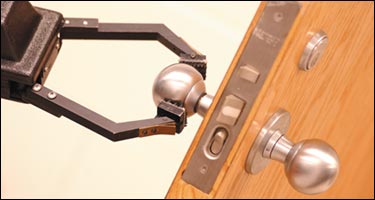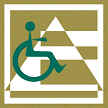| Biosciences -
Partnerships Range from Robotics to Health Care
Story by Ann Carney. Photos by Jason Marsh.
It's the kind of collaboration that will change lives, develop new
medical treatments and advance cures for disabling conditions and
diseases. It will also promote economic development, facilitate the
commercialization of discoveries and propel the state into its rightful
place in science and technology. And it's happening right here at the
University of South Florida.
USF's new Center of Excellence in
Bioengineering and Life Sciences brings together an arsenal of
multidisciplinary strengths and a cluster of more than 370 regional
medical manufacturing companies for the development and commercialization
of innovative products and technologies that will improve lives and may
eventually change the face of healthcare.
But that's not all. The
new Center of Excellence will create jobs, attract world-class talent,
generate new research dollars and enhance classroom learning at all
levels.
Sound far-fetched? USF is combining talents of engineers and
physician/researchers to address health care problems that plague millions
of Americans. Engineers are refining incredible robots and robot devices
that can help people with physical mobility challenges -- from arthritis
to paralysis -- have new-found independence. Robot arms that can be
mounted on a wheelchair can manipulate your keys and unlock a door, turn
the knob and push open the door. Tiny "marsupial" robots can fetch objects
out of reach. These innovations can dramatically change the lives of the
aging and disabled who struggle to bend down, twist and turn, reach high
and manipulate small objects.
 But the future is even more promising, as USF
medical researchers work to develop innovative cells that can actually
repair damaged tissue-like skin and even brain and nerve cells. "The aim
is to help people with disabilities manage their mobility challenges in
the short term until we can develop cures that fully restore their ability
to stand, walk or maneuver. This is about a vision to dramatically improve
people's lives," says Dr. Carl Carlucci, executive vice president for USF. But the future is even more promising, as USF
medical researchers work to develop innovative cells that can actually
repair damaged tissue-like skin and even brain and nerve cells. "The aim
is to help people with disabilities manage their mobility challenges in
the short term until we can develop cures that fully restore their ability
to stand, walk or maneuver. This is about a vision to dramatically improve
people's lives," says Dr. Carl Carlucci, executive vice president for USF.
"There is a real match between the university's strengths and what
we can do in the community in an area where we have a number of successful
research initiatives," says Carlucci. "The new Center of Excellence is
directly aligned with the university's strategic plan. It brings a focus
to our research energies where we have a competitive
advantage."
The rationale is simple. USF's renowned medical school,
outstanding engineering program and
basic science research activities combined with a history of success in
interdisciplinary collaboration, provides a unique combination of
strengths. At the intersection of those strengths lies bioengineering and
the life sciences.
Moreover, the Tampa Bay area is home to one of
the nation's largest clusters of medical products companies, offering the
industry infrastructure that is vital to a successful alliance between
university research and business. Though not widely known, this medical
products cluster contributes more than 51,000 jobs and $5 billion to the
Tampa Bay region.
"This is a global industry with a positive
economic impact," says Geary Havran, president of Tampa Bay-based NDH
Medical Inc. and president of the Florida Medical Manufacturers'
Consortium. "Success here will breed new opportunities‹opportunities that
are dependent on the stream of input that comes from university
research."
All things considered, Havran says, the region has all
the ingredients for success in the biotechnology industry. Within the
state, the Tampa Bay area has one of the strongest industry bases to
ensure success. Add to that the university's reputation as one of the
country's leading research institutions and the synergy becomes
obvious.
Focused Research
The new Center
of Excellence will focus on four key areas of research and development:
medical devices and manufacturing methods; rehabilitation engineering for
people with disabilities; biosensors and medical imaging; and new
technologies for drug delivery.
"What we are trying to facilitate
here is interdisciplinary research‹work that lies at the boundaries of
different fields," says Dr. Louis Martin-Vega, dean of the College of Engineering. "We're talking
about the kind of research that is driving the development of new
technology."
That makes good business sense, according to Carlucci,
who says the new Center of Excellence parallels national investments and
the national agenda -- an agenda that rewards and expects
interdisciplinary research.
Enhanced
Educational Experience
For USF students, bringing research
strengths together in one College of Engineering provides an innovative
and rich learning environment. It creates a hub where traditional
disciplines, each with their own culture and language,
intersect.
In the past students spoke only one technical language.
They approached challenges from a single perspective. That's no longer
enough, says Dr. Bruce Lindsey, Professor of Physiology and Biophysics in
the USF College of Medicine.
Success in today's complex and competitive environment depends on the
blending of a variety of disciplines and scientific
principles.
Consider medical imaging, for example. Through imaging
technology, doctors can identify and diagnose medical conditions. The
actual capture of data, however, involves a computer device. By working
together and understanding one another, doctors, technicians and computer
scientists can develop the technology that best captures the information
doctors need to arrive at the most accurate diagnosis and effective
treatment. That, simply put, is the intersection of bioengineering and the
life sciences.
"We are hoping to develop students who are fluent
in more than one technical language," says Lindsey. "If you get students
in an environment like this, they become truly multilingual."
World-Class Faculty
Bringing
focus and depth to the research enterprise through the new Center of
Excellence creates a magnet to attract and retain truly talented people
who can provide new ideas and innovative concepts that will ultimately
lead to new products and technologies.
"Traditionally, academics
have stayed within the walls of universities," says Lindsey. "It is only
in the past 10 to 15 years that scientists have begun to think
entrepreneurially -- how to do things that will have a greater impact on
society."
This focus will strategically facilitate that
interaction between science and the community.
Additionally, that
interaction builds on the success of USF's Center for Entrepreneurship and
its business incubator that helps move discoveries from the laboratory to
new or existing area businesses. It's the kind of muscle, along with
partnerships with H. Lee Moffitt
Cancer Center and Research Institute, the James A. Haley Veteran's
Hospital, Tampa General Hospital, a consortium of colleges and
universities and an array of strategic affiliates, that makes the concept
so powerful.
Community and Industry Impact
The
potential impact of the new Center of Excellence outside the campus
boundaries cannot be overstated. Through its partnerships with regional
industrial affiliates, the center will bridge the gap between academia and
industry, a gap that has long existed in the Tampa Bay region, according
to Suzanne Christman, business development manager for Pinellas County
Economic Development.
"We've always known there's a lot going on at
USF, but we haven't known how to work with the university," says
Christman. "This new center is the bridge that will close the gap. It will
give us an avenue to directly link industry with the university."
Why
is that important?
Manufacturers rely on new products to strengthen
and grow their businesses. Medical devices have a very short life
cycle. New devices replace existing ones every year so so. Research that
improves the function and efficiency of current devices is essential as
well as a constant stream of new ideas for developing totally new
products.
And this university-industry collaboration creates new
high-tech jobs as well. For every engineer working on a single device,
industry needs at least ten skilled technicians to support their efforts.
So community colleges are partnering with USF to provide specialized
training to assure their are enough highly skilled workers to support the
growing biotech industry in Tampa Bay.
An industrial advisory board
with representatives from industry and the university anchors the
partnership, says Lindsey. The board will ensure that industry partners
actively participate in the strategic guidance and management of all
aspects of the center, from research project selection and evaluation to
strategic planning and marketing.
"This has been a true
collaborative effort from the start," says Martin-Vega. "We have tried to
involve as many people as possible, from inside and outside the
university, in every part of the design."
A Full Circle Process
"This is
not a linear thing, it is a full circle process that feeds back to basic
research," says Martin-Vega. "We are creating a cycle that, until now,
didn't exist." That cycle involves students, faculty and industry, all
building on existing strengths to achieve success.
"From concept
to commercialization, we have all the necessary ingredients here to make
it happen," says Mike Kovac, acting director of the Nanomaterials and Nanometrics Research
Center at USF. "It is in the best economic, cultural and political
interests of the state to have this kind of focused activity taking
place." It's a tangible way that USF is touching lives, improves medical
treatment and innovation, and makes a real difference for the people and
businesses of Florida.
|

